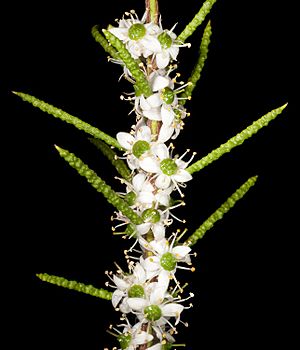Philotheca deserti facts for kids
Quick facts for kids Philotheca deserti |
|
|---|---|
 |
|
| Near Beacon, Western Australia | |
| Scientific classification | |
| Genus: |
Philotheca
|
| Species: |
deserti
|
| Synonyms | |
|
|
Philotheca deserti is a type of flowering plant. It belongs to the Rutaceae family, which also includes citrus fruits. This plant is special because it is found only in inland Western Australia. It grows as an upright bush with long, narrow leaves. These leaves have small bumps, like warts, that are actually tiny glands. The plant produces pretty white flowers. Each flower usually grows by itself where a leaf joins the stem.
Contents
What it Looks Like
Philotheca deserti is a shrub that can grow between 1 and 2 meters tall. That's about as tall as a person! Its branches have a corky feel.
Leaves
The leaves are quite unique. They are narrow and shaped a bit like a spindle, which is wider in the middle and tapers at both ends. They are about 20 to 30 millimeters long. That's roughly the length of two small paperclips. The leaves also have tiny bumps called glands, and they have a groove on their top surface.
Flowers
The flowers are usually white. They grow mostly one by one where the leaves meet the stem. Sometimes, you might see two or three flowers together. Each flower sits on a tiny stalk called a pedicel. This stalk is very short, only about 0.5 to 5.5 millimeters long.
Each flower has five round parts called sepals, which are like small green leaves protecting the bud. These are about 1 millimeter long. It also has five white petals that are shaped like an egg, about 3 millimeters long. Inside the flower, there are ten stamens, which are the parts that produce pollen. They are all separate from each other.
Philotheca deserti usually blooms from April to June or in October. After the flowers, small fruits appear. These fruits are about 2.5 millimeters long and have a short, pointed tip.
How it Got its Name
This plant was first officially described in 1904. A scientist named Ernst Georg Pritzel gave it the name Eriostemon desertii. He wrote about it in a science journal called Botanische Jahrbücher für Systematik, Pflanzengeschichte und Pflanzengeographie. He found the first samples of the plant near a place called Southern Cross.
Later, in 1998, another scientist named Paul Wilson changed its name to Philotheca deserti. He also identified two slightly different types of this plant, which he called subspecies. He published his findings in a journal called Nuytsia.
Subspecies
- Philotheca deserti subsp. brevifolia: This type has shorter leaves, only about 3 to 5 millimeters long.
- Philotheca deserti subsp. deserti: This is the more common type, with leaves that are 20 to 30 millimeters long.
Where it Lives
Philotheca deserti grows in the dry, inland areas of Western Australia. You can find it on rolling plains and hills. It grows in the regions between the towns of Kalgoorlie, Menzies, and Yalgoo. These areas are part of specific natural zones called biogeographic regions, including the Avon Wheatbelt, Coolgardie, and Murchison regions.
Conservation Status
The Western Australian Government's Department of Parks and Wildlife keeps track of plants and animals. They have classified Philotheca deserti as "not threatened." This means that the plant is not currently in danger of disappearing.
However, one of its subspecies, brevifolia, is listed as "Priority Three." This means that scientists don't know much about it, and it's only found in a few places. Even though it's not in immediate danger, it's still important to keep an eye on it and protect its habitats.

